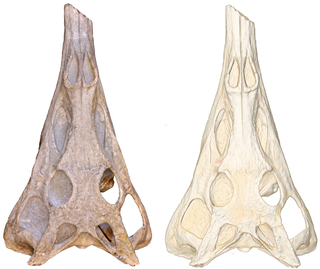
Paleorhinus is an extinct genus of widespread basal phytosaur known from the Late Triassic. The genus was named in 1904 based on the type species Paleorhinus bransoni, which is known from Wyoming and Texas in the United States. Another valid species, Paleorhinus angustifrons from Bavaria, Germany, is also commonly referred to the genus. Paleorhinus had a length of about 2.5 meters.

Ebrachosuchus is an extinct genus of basal phytosaur known from the Late Triassic of Bavaria, southern Germany. It is known only from the holotype BSPG 1931 X 501, a complete skull missing both mandibles. It was collected at Ebrach Quarry, bed number 9 from the late Carnian-aged Blasensandstein Member of the Hassberge Formation. It was first named by Oskar Kuhn in 1936 and the type species is Ebrachosuchus neukami.

The southern spotted skunk is a species of mammal in the skunk family, (Mephitidae). It ranges from Costa Rica to southern Mexico. At one time this skunk was considered to be a subspecies of the eastern spotted skunk.
Scalenodon is an extinct genus of traversodontid cynodonts from the Middle Triassic of Africa and possibly Russia. The type species S. angustifrons was named in 1946 and several other species were named in the following years. Most of the species from Africa are now thought to belong to different genera than Scalenodon.
Calliini is a tribe of longhorn beetles of the subfamily Lamiinae.
Drycothaea is a genus of longhorn beetles of the subfamily Lamiinae.
Drycothaea jolyi is a species of beetle in the family Cerambycidae. It was described by Galileo and Martins in 2010. It is known from Peru.
Drycothaea bicolorata is a species of beetle in the family Cerambycidae. It was described by Martins and Galileo in 1990. It is known from Ecuador and Brazil.
Drycothaea brasiliensis is a species of beetle in the family Cerambycidae. It was described by Stephan von Breuning in 1974. It is known from Brazil and French Guiana.
Drycothaea mexicana is a species of beetle in the family Cerambycidae. It was described by Breuning in 1974. It is known from Mexico.
Drycothaea turrialbae is a species of beetle in the family Cerambycidae. It was described by Breuning in 1943. It is known from Costa Rica.
Drycothaea cribrata is a species of beetle in the family Cerambycidae. It was described by Bates in 1881. It is known from Honduras, Mexico and Guatemala.
Drycothaea stictica is a species of beetle in the family Cerambycidae. It was described by Bates in 1881. It is known from Belize, Guatemala, Honduras, Mexico, Panama, and El Salvador.
Drycothaea curtula is a species of beetle in the family Cerambycidae. It was described by Bates in 1885. It is known from Panama.
Drycothaea parva is a species of beetle in the family Cerambycidae. It was described by Bates in 1885. It is known from Honduras and Panama.
Drycothaea spreta is a species of beetle in the family Cerambycidae. It was described by Henry Walter Bates in 1885. Its known habitat is Mexico.
Drycothaea estola is a species of beetle in the family Cerambycidae. It was described by Lameere in 1893. It is known from Venezuela.
Drycothaea indistincta is a species of beetle in the family Cerambycidae. It was described by Lingafelter and Nearns in 2007. It is known from the Dominican Republic.
Drycothaea sallei is a species of beetle in the family Cerambycidae. It was described by Thomson in 1868. It is known from Mexico, Guatemala and Belize.
Drycothaea viridescens is a species of beetle in the family Cerambycidae. It was described by Buquet in 1857. It is known from Argentina, Brazil and Paraguay.


